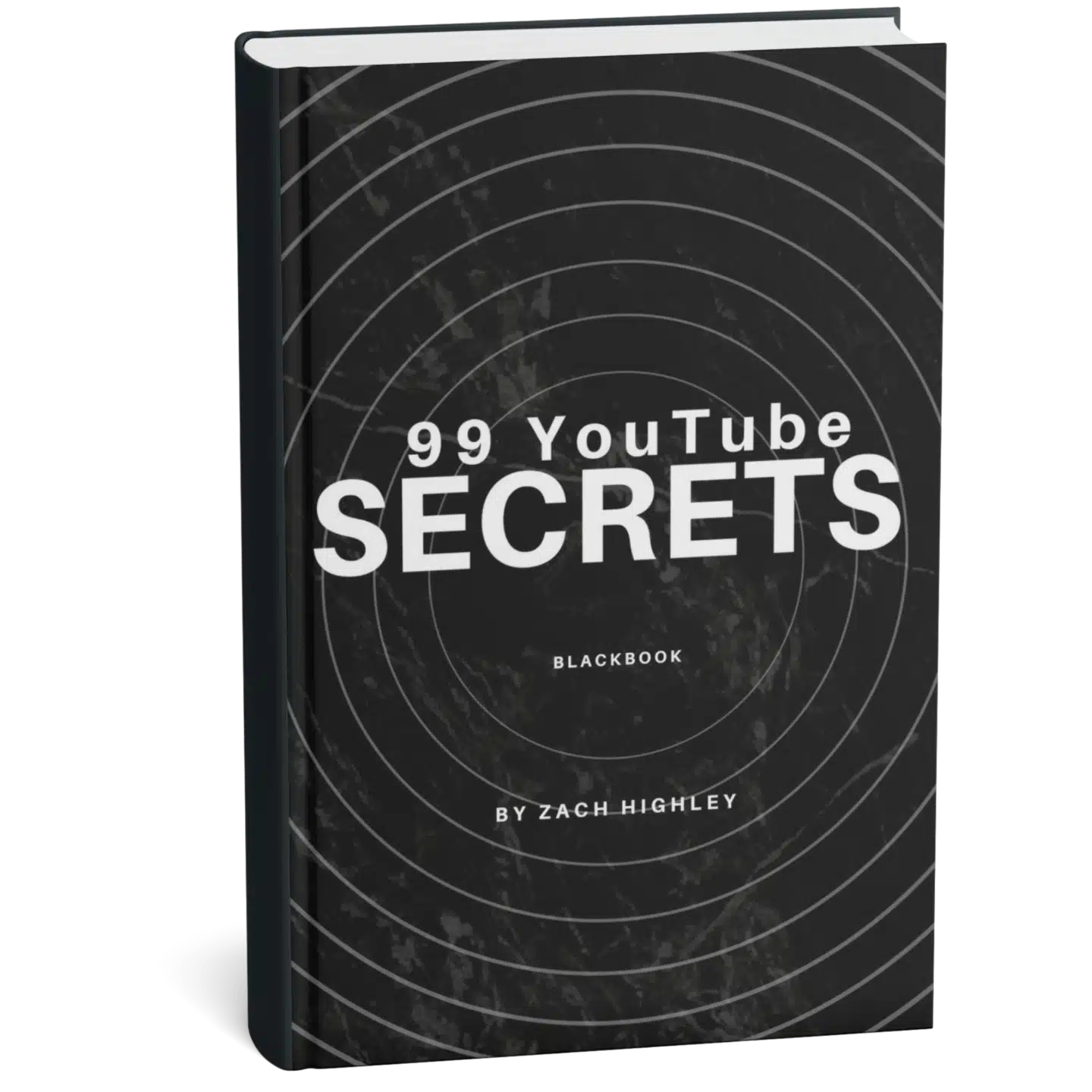YouTube 101
Your Step-by-Step Guide to Starting a Life-Changing Channel
Quiz: What's Your Creator Personality Type?⬇️ Jump to the list of Articles ⬇️How to Build a YouTube Channel That Generates Real Wealth
Introduction
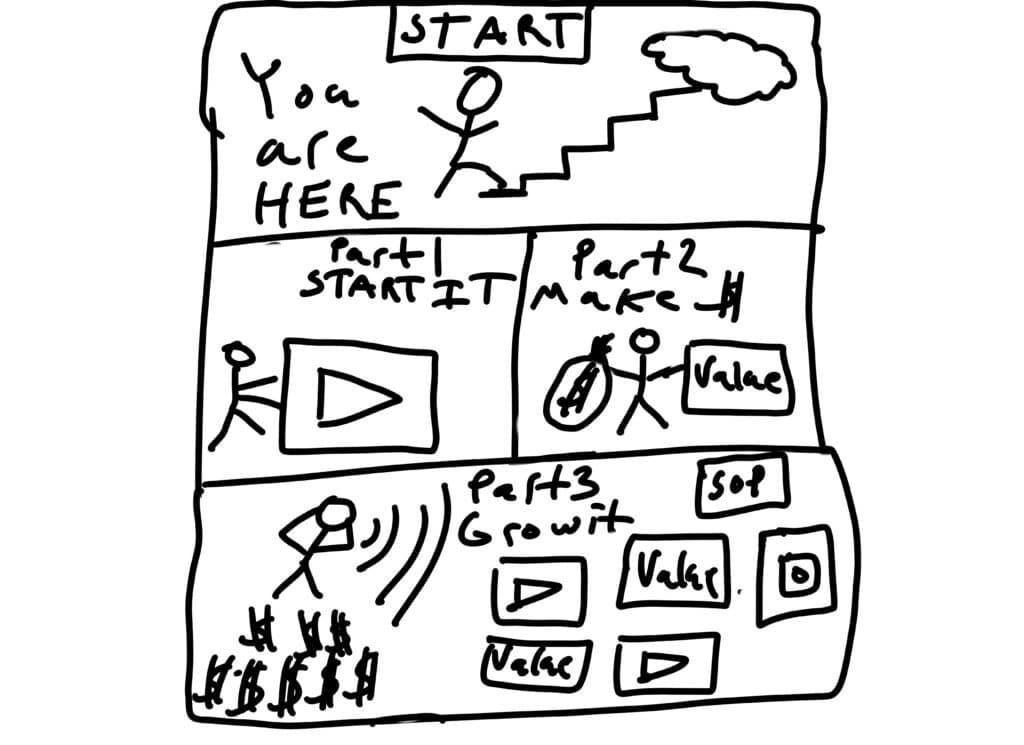
(All images in this post are hand-drawn by me, I know you are very impressed)
This guide reveals the systematic approach that allows ordinary people to build extraordinary YouTube businesses, backed by evidence from Stanford research, documented success stories, and data from the creator economy’s most successful entrepreneurs as well as my personal 5-year journey from 0 subscribers to 500,000 and financial freedom.
Important Note: This guide is for people who want to start a YouTube channel that generates wealth (like a business). If you are simply interested in making YouTube videos for fun, this guide is not for you.
Steps 1-3 will teach you how to make content, while steps 4-6 will teach you how to monetize that content professionally.
Step 1: Why Become a Creator
1.1 SoloTuber vs RegTuber
YouTube is poised to change your life—but not in the way you’ve been told.
Picture two creators. Both started their channels on the same day. Both post weekly. Both have decent cameras and editing skills. But their lives couldn’t be more different.
Sarah the RegTuber wakes up at 5 AM to film before her day job. She posts daily, chasing trends and praying for the algorithm to notice her. With 250,000 subscribers, she makes $2,000/month from ads—when YouTube doesn’t demonetize her videos. She’s exhausted, bitter, and secretly resents her audience for not watching enough. She spends 40 hours a week on YouTube to make less than minimum wage.
Marcus the SoloTuber films one video every Sunday afternoon. With 50,000 subscribers, he makes $15,000/month from digital products. He owns his audience’s email addresses, works 10 hours per week, and just booked a month in Bali—his third workcation this year. He turned down a sponsorship last week because he was “too busy” enjoying life.
What’s the difference? Sarah built an audience. Marcus built a business.
Forget the prevailing narrative. The endless chase for viral hits, the obsessive refreshing of the subscriber count, the desperate prayers to the algorithm gods—these are the hallmarks of a hobby, not a business and the common downfall of the RegTuber (regular YouTuber).
While the majority of creators are trapped on a content hamster wheel, trading their time for pennies from ad revenue, a select few are building systems of wealth and freedom. These are SoloTubers (Solo YouTubers that create a life of freedom and happiness by publishing videos consistently that converts viewers to customers without hiring a team, depending on the algorithm, or having to keep up with the trends).
1.2 The SoloTuber Revolution

Let me define this clearly, because understanding this distinction will determine whether you build a job or build freedom:
SoloTuber Definition: A SoloTuber is someone who lives life on their own terms by creating and sharing valuable content that generates income consistently so they can live a life of freedom and happiness.
| Traditional YouTube Path | SoloTuber Path |
|---|---|
| 1. Create content | 1. Create valuable content |
| 2. Chase views | 2. Build email list |
| 3. Hope for ad revenue | 3. Develop products |
| 4. Burn out | 4. Automate systems |
| 5. Quit | 5. Live freely |
Mindset shifts that matter:
Shift 1: From Hobbyist to CEO ❌ Old: “I make videos” ✅ New: “I run a media business”
Shift 2: From Views to Value ❌ Old: “I need more views” ✅ New: “I need the right viewers”
Shift 3: From Platform to Portfolio ❌ Old: “YouTube is my business” ✅ New: “YouTube is my marketing department”
Shift 4: From Perfect to Published ❌ Old: “It’s not ready yet” ✅ New: “Version 1 is better than version none”
Shift 5: From Solo to Systems ❌ Old: “I do everything myself” ✅ New: “I build systems that scale”
📝 Do This Now Box (2 minutes): Before you read another word:
- Open your phone’s notes app
- Type: “I am beginning my SoloTuber journey on [today’s date]”
- Screenshot it
- That’s it—you’re no longer “thinking about it”
1.3 My $10,000 Reality Check
Let me take you back to my final month as a doctor. I was 29, working 80-hour weeks, sleeping in hospital call rooms, and questioning every life choice that led me there.
But here’s the crazy part: That month, without recording a single new YouTube video, I made:
| Income Source | Amount |
|---|---|
| Course sales (Anki Mastery, Beginner YouTube) | $5,200 |
| Sponsorship (NordVPN, 90-second integration) | $3,500 |
| YouTube AdSense | $2,067 |
| Affiliate sales (Amazon, software) | $367 |
| Total | $11,134 |
I hadn’t touched my channel in 3 months. The videos were pre-recorded, the email sequences automated, the products delivering themselves. While I was intubating patients at 3 AM, my systems were making sales.
That’s when I knew: I could walk away from medicine.
1.4 The Platform Risk Nobody Discusses
Here’s a horror story that should terrify every creator: Graham Stephan, finance YouTuber with 4 million subscribers, saw his revenue drop 80% overnight when YouTube changed its monetization policies in 2020. His videos went from $40 CPM to $8 CPM. No warning. No recourse. No appeal.
The Platform Control Matrix:
| Platform | Who Owns It | Your Control | Risk Level | Horror Story |
|---|---|---|---|---|
| YouTube Subscribers | Zero | 🔴 Extreme | Channels deleted without warning | |
| Instagram Followers | Meta | Zero | 🔴 Extreme | Reach dropped 90% overnight |
| TikTok Followers | ByteDance | Zero | 🔴 Extreme | Banned in multiple countries |
| Email List | You | Complete | 🟢 Low | You own the relationship |
| Customer List | You | Complete | 🟢 Low | Direct access forever |
A study by Content Entrepreneur found:
- 23% of creators lost 50%+ income from algorithm changes
- 14% had channels/accounts suspended without cause
- 8% lost their entire platform presence overnight
- 92% regretted not building an email list sooner
1.5 Freedom Number
Before you ever brainstorm a video idea, buy a microphone, or design a thumbnail, you must complete the most critical task of your entire journey: you must define your destination.
Your goal is not one million subscribers. Your goal is freedom. And freedom can, and must, be quantified. We call this your Freedom Number.
The Freedom Number is the precise amount of monthly profit required from your business to cover your total living expenses, thereby liberating you from reliance on a job you do not love.
The Freedom Number is the antidote to “more.” It is a finish line. It is specific, measurable, and achievable. Hitting your Freedom Number doesn’t mean you stop working or growing, but it means that all work you do from that point forward is done out of choice and passion, not necessity.
The psychological weight that is lifted when you reach this point is indescribable and it is a safety check before you get trapped on the hedonic treadmill.
📚 Intellectual Resource: The concept of “The 4-Hour Workweek” by Tim Ferriss, while now a classic, was groundbreaking in its promotion of defining your target monthly income and designing a business to hit it. Reading the initial chapters on “Deal-making” and “Dreamlining” will powerfully reframe your financial goals.
The Calculation
Do not estimate this. Do not guess. This exercise will take you 30 minutes, and it will be the most valuable 30 minutes of your week.
Step 1: Open a Spreadsheet or Grab a Notebook Create a new Google Sheet, Excel file, or use a physical notebook. Title it “My Freedom Number.”
Step 2: List Your Core Living Expenses This is the bare-bones budget. Go through your bank and credit card statements for the last three months to get accurate averages.
- Housing: Rent or Mortgage Payment
- Utilities: Electricity, Water, Gas, Internet, Phone Bill
- Transportation: Car Payment, Insurance, Gas, Public Transit
- Food: Groceries (be honest about your average spending)
- Insurance: Health Insurance, Renter’s/Homeowner’s Insurance, Life Insurance
- Debt Repayment: Student Loans, Credit Card Debt, Personal Loans (list the minimum payments)
Step 3: List Your “Quality of Life” Expenses Freedom isn’t just about surviving; it’s about thriving.
- Restaurants & Entertainment: Coffee, Dining Out, Movies, Concerts
- Subscriptions: Netflix, Spotify, Gym Memberships, etc.
- Shopping: Clothing, Household Goods, etc.
- Personal Care: Haircuts, etc.
Step 4: Add Buffers for the Unexpected and the Future This is the step most people miss.
- Taxes: Your business profit is not your take-home pay. A safe rule of thumb is to set aside 30% of your profit for taxes.
- Savings & Investing: What amount do you want to be putting away for retirement or other long-term goals each month? (e.g., $500)
- “Buffer” Fund: Life is unpredictable. Add a 10-15% buffer to your total for unexpected costs (car repairs, medical bills, etc.).
Step 5: The Calculation Let’s walk through a hypothetical case.
| Expense Category | Monthly Cost |
|---|---|
| Core Expenses | |
| Rent | $1,500 |
| Utilities (Total) | $250 |
| Transportation (Total) | $300 |
| Groceries | $400 |
| Health Insurance | $350 |
| Student Loan | $200 |
| Subtotal Core: | $3,000 |
| Quality of Life | |
| Dining & Entertainment | $300 |
| Subscriptions | $50 |
| Shopping & Personal | $150 |
| Subtotal QoL: | $500 |
| Future & Buffer | |
| Savings/Investment | $500 |
| Total Expenses: | $4,000 |
| Add 15% Buffer: | $600 |
| Total Monthly Need: | $4,600 |
This $4,600 is your monthly take-home pay target.
Now, let’s factor in taxes. To safely take home $4,600, you need to earn more to account for taxes. A simple way to estimate this is to divide your target by (1 – your estimated tax rate). Using a 30% tax rate (0.3):
Freedom Number (Pre-Tax Monthly Profit) = $4,600 / (1 – 0.3) = $4,600 / 0.7 = ~$6,571
This is your target. Your business needs to generate $6,571 in profit per month.
The Reality Check
This number, ~$6,600/month, might seem large, but let’s break it down from a SoloTuber’s perspective.
Ad Revenue: A channel focused on a valuable niche (like finance or software) might earn a $20 RPM (Revenue Per Mille, or per 1000 views). To make $6,600 from ads alone, you’d need 330,000 views per month. This is achievable but puts you at the mercy of the algorithm.
The SoloTuber Model: What if you sold a digital product?
| Product Type | Price | Sales Needed/Month | Sales/Day |
|---|---|---|---|
| Online Course | $97 | 68 | 2.3 |
| eBook/Templates | $27 | 244 | 8.1 |
| Coaching Package | $497 | 14 | 0.5 |
When you frame it this way, the goal becomes tangible. You don’t need millions of views. You need to build a system that can reliably generate 2 sales a day. That is a marketing challenge, not a fame challenge.
✅ ACTION ITEM: Write your Freedom Number down. Put it on a sticky note on your computer. Make it the wallpaper on your phone. This is your North Star. Every decision you make—every video you create, every product you develop—should be in service of reaching this number.
1.6 Creator Journey
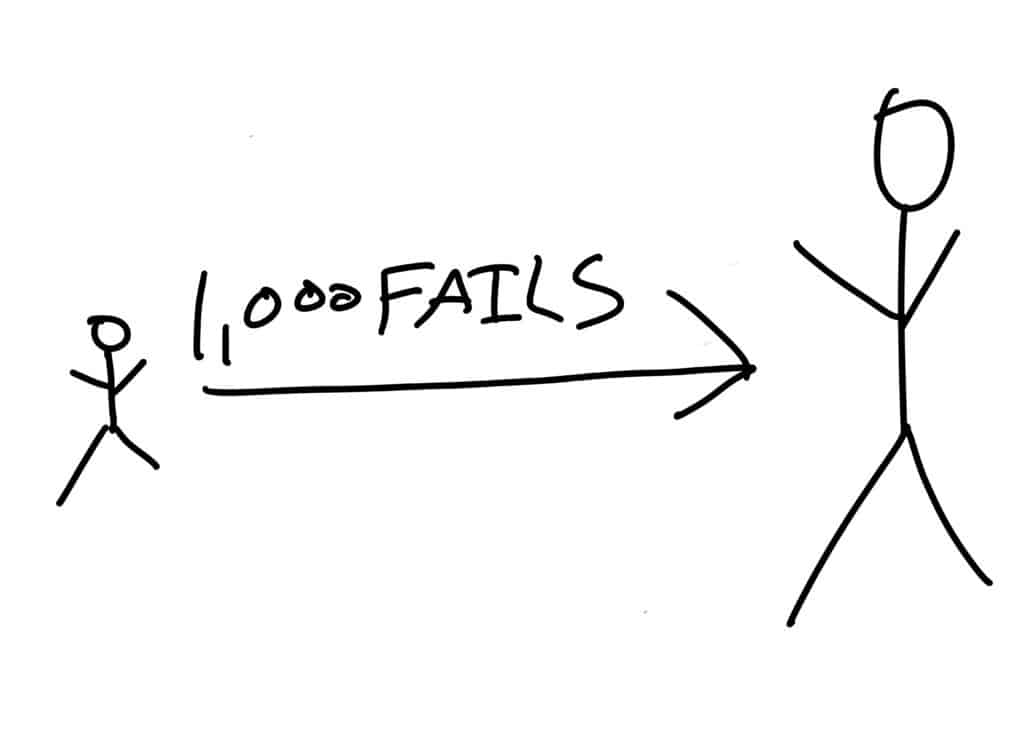
The path of a creator is not a simple, linear progression. It is a journey fraught with internal and external challenges.
The author Joseph Campbell, in his seminal work The Hero with a Thousand Faces, codified a fundamental pattern that appears in myths and stories across all human cultures: The Hero’s Journey.
Understanding this framework is not an academic exercise; it’s a powerful tool for navigating the emotional and psychological challenges of putting yourself and your work out into the world.
As a SoloTuber, you are the hero of your own story.
The Call
Every journey begins with a “Call to Adventure.” This is the moment you first feel the pull to create, the inkling that a different life is possible. It’s the voice that says, “What if I started a YouTube channel?” or “I could teach people about this.”
But immediately following the call comes the “Refusal of the Call.” This is the voice of fear and self-doubt.
- “Who am I to teach this? I’m not an expert.”
- “What will my friends and family think?”
- “I don’t have the right camera/microphone/software.”
- “I’ll probably fail, so why even try?”
This is the first great filter. The vast majority of people who feel the call to create never move past this stage. They let fear win.
The SoloTuber’s first act of courage is to acknowledge the fear and take action anyway. The goal is not to be fearless; the goal is to act in spite of fear.
📺 Actionable Resource: Watch Ali Abdaal’s video “How to Overcome the Fear of Starting a YouTube Channel” directly addresses the psychological hurdles and provides practical reframes that are essential for any beginner.
The Mentors
No hero succeeds alone. They always encounter a mentor figure who gives them a tool, a piece of advice, or a map to help them on their way.
In the digital age, your mentors may not be a single wise old master, but a collection of creators you admire. People like Ali Abdaal, MKBHD, Casey Neistat, Matt D’avella, and Thomas Frank were my digital mentors. This guide, and the book SoloTuber, are designed to be your map.
“Crossing the Threshold” is the moment you commit. It’s the moment you move from thinking to doing. In the context of YouTube, this has a very specific meaning: publishing your first video.
This is the point of no return. The video is public. You have declared your intentions to the world. It is one of the most terrifying and exhilarating moments of the entire journey. You have officially stepped out of the “ordinary world” and into the “special world” of a creator.
The Trials
Once in the special world, the hero faces a “Road of Trials”—a series of tests designed to challenge them and force them to grow. For a SoloTuber, these trials are rarely external monsters; they are internal ones.
🎭 Imposter Syndrome: The persistent feeling that you are a fraud and will be “found out” at any moment. You will feel this. Even the most successful creators admit to feeling it.
The cure is not to wait until you feel like an expert. The cure is action. Every video you publish, every helpful comment you leave, every thank-you email you receive from a subscriber is evidence that refutes the voice of imposter syndrome. You overcome it by accumulating proof of your value, one piece of content at a time.
🎯 The Perfectionism Trap: The belief that your work must be flawless before it can be shared. Perfectionism is fear in a fancy costume. You use the excuse of “making it better” to avoid the scary act of publishing.
Your first ten videos will be bad. Your first fifty will be mediocre. That is part of the process. The only way to make good videos is to make lots of bad videos first. As Voltaire said, “The perfect is the enemy of the good.”
📊 The Comparison Game: You will look at creators with millions of subscribers and professional-grade studios and feel hopelessly inadequate. This is like a novice hiker looking at the peak of Mount Everest and giving up.
You must not compare your Chapter 1 to someone else’s Chapter 20. The only comparison that matters is you today vs. you yesterday. Are you learning? Are you improving? Are you still taking action?
📚 Mindset Masterclass: For a deep, philosophical take on overcoming these creative battles, Steven Pressfield’s book “The War of Art” is required reading. He gives a name to the force of self-sabotage—”Resistance”—and provides a warrior’s ethos for defeating it every day.
Navigating the Road of Trials is what forges you into a true SoloTuber. Every challenge overcome builds resilience, and every video published hones your skill. This is the heart of the journey.
🎯 Step 1 Action Items:
☐ Calculate your exact Freedom Number (use worksheet above)
☐ Write it on a sticky note and put it on your monitor
☐ Choose: RegTuber or SoloTuber path?
☐ Accept that your first 10 videos will suck
☐ Set a “quit my job” # (even if it’s forever away, and only if you want to quit your job)
☐ Complete the “Do This Now” box
☐ Text 5 friends about your commitment
Step 2: Finding Your Niche
2.1 Zone of Leverage
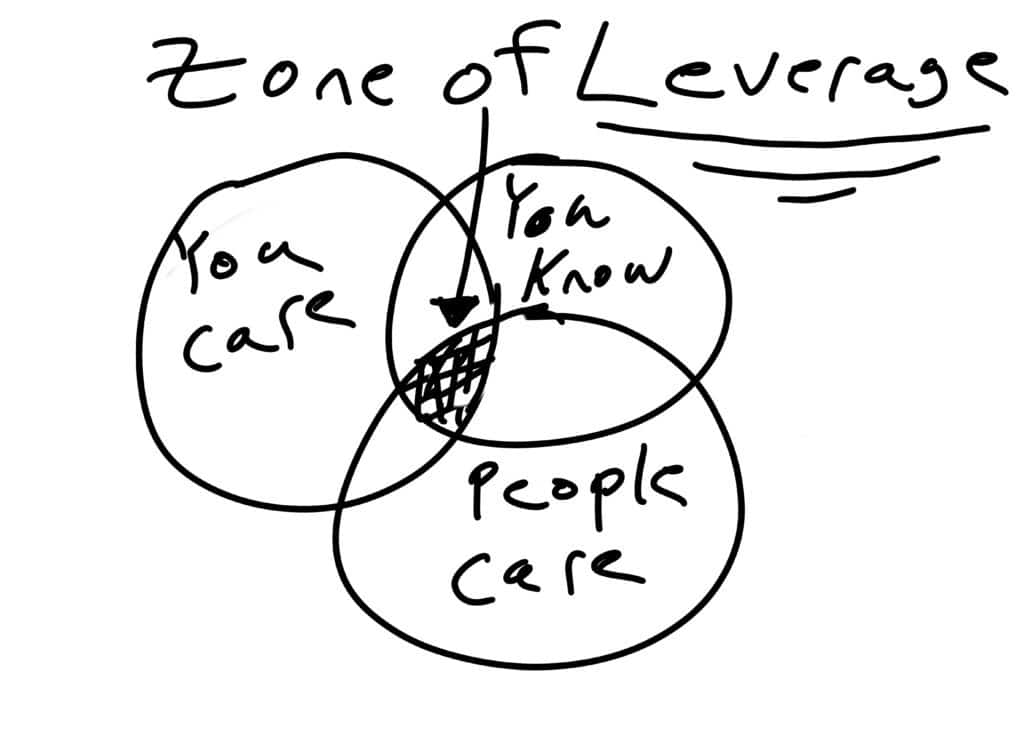
Your Zone of Leverage is the intersection of:
- What you care about
- What others care about
- What you’re good at
This is something I created when trying to help new creators decide on their niche. Here’s how to find yours.
Discovery Process
Step 1: Info-IN Analysis Write down the last 10 things you:
- Watched on YouTube
- Read (books, articles, blogs)
- Talked to friends about
- Listened to (podcasts, audiobooks)
Step 2: Subconscious Analysis Write down the last 10 things you thought about while doing menial tasks like washing dishes, showering, or driving.
Step 3: Info-OUT Analysis Write down:
- 5 things people commonly ask you about
- 5 skills that come easier to you than others
- 5 areas where you have extended experience
Step 4: Find the Overlap Look for topics that appear in multiple categories. These represent your Zone of Leverage.
2.2 Passion Audit
Grab your notebook. Set a timer for 20 minutes and brainstorm, uncensored.
- What topics do you find yourself reading books about or watching videos on late at night?
- What sections of a bookstore do you naturally gravitate towards?
- If you had a free Saturday with no obligations, what project would you joyfully work on?
- What do your friends and family say you “never shut up about”?
- What problems have you solved in your own life that you are proud of? (e.g., building a budget, learning a new language, mastering a difficult recipe, navigating a career change)
2.3 Skill Inventory
List every skill you have, big or small. Think broadly.
- Hard Skills: These are teachable, technical abilities (e.g., coding in Python, using Adobe Photoshop, playing the guitar, speaking Spanish, analyzing financial statements).
- Soft Skills: These are interpersonal abilities (e.g., public speaking, simplifying complex topics, negotiating, being incredibly organized, empathetic listening).
- Experience-Based Skills: Skills gained through life (e.g., parenting a child with ADHD, successfully applying for scholarships, planning a wedding on a budget).
Now, look at the overlap between your passion list, skill list, and info list. Where’s the overlap? Which 3 topics seem most interesting to you?
2.4 Market Validation
Take your top 3 ideas from the overlap above and validate them.
- 📺 The YouTube Test: Type your topic into the YouTube search bar. Do videos appear with significant view counts (10,000+)? Are creators building entire channels around this? This is good.
- 💰 The “Are They Selling?” Test: Are these creators monetizing through more than just ads? Do they have links to courses, coaching, eBooks, or affiliate products in their descriptions? This is an excellent sign that the audience is willing to pay for value.
- 📚 The Amazon Book Test: Search for your topic on Amazon. Are there multiple books with lots of positive reviews? This proves a paying market exists.
- 📰 The Magazine Test: Does this topic have dedicated magazines? (e.g., Gardener’s World, PC Gamer, Men’s Health). Magazines are businesses that have already validated the niche.
Real Creator Success Stories
| Creator | Channel | Started With | Struggle | Now | Secret |
|---|---|---|---|---|---|
| Kevin Espiritu | Epic Gardening | Teaching urban gardening from tiny apartment | Killed every plant for years | 8-figure business, 4M+ subs | Documented learning, not expertise |
| Caitlin Shoemaker | Frugal Vegan | Cheap plant-based meals for broke students | Eating disorder recovery + debt | Full-time creator, cookbook author | Solved her own problem publicly |
| Thomas Frank | College Info Geek | Study and productivity tips | Not much, he’s a beast | Notion business that’s 7+ figures a year | Taught what he wanted to learn |
Pattern: They all started by solving their own problems
Side note: this doesn’t always have to be true. For example, I started on Anki and there were very few if any materials around this online (that’s why I started making videos around it).
2.5 Idea Mining
This framework helped me generate 100 video ideas in 30 minutes:
Formula: 10 Big Ideas × 10 Specific Topics = 100 Video Ideas
Example for Personal Finance:
5 General Content Areas:
- Budgeting and saving
- Investing strategies
- Side hustles
- Debt elimination
- Retirement planning
5 Questions People Ask:
- How much should I save?
- Where should I invest?
- How to start a side business?
- How to pay off debt fast?
- When can I retire?
Breaking Down “Budgeting and Saving” (10 specific topics):
- Budget apps that actually work
- The envelope method explained
- How to save on groceries
- Emergency fund vs. debt payoff
- Automating your savings
- Budget for irregular income
- Saving for vacation guilt-free
- Teaching kids about money
- Cutting expenses without misery
- Budget mistakes to avoid
Repeat for all 10 areas = 100 videos!
2.6 Creator Voices
Now, how will you relay your information?
- 🗺️ The Adventurer (Best for Most People) Document your journey as you learn. Use “How I learned” instead of “How to do.” This builds relatability and allows authenticity about your current skill level.
- 📰 The Reporter Research and share expert information. Perfect for people who love research but aren’t experts yet. Cite studies like those from Harvard Business Review or Journal of Applied Psychology.
- 🏆 The Hero Share your story after accomplishing something significant. Use if you have clear credentials or major achievements.
2.7 Bio Creation

How do people know who you are? Simplify, simplify, simplify until you can write your bio one-liner. Then put this everywhere your face is online.
Formula: “I help people _______, I’m _______ (proof if available).”
Examples:
- “I help people get healthier and lose weight, I’m an obesity specializing physician”
- “I help people manage money better, I’m a financial advisor who paid off $50K in debt”
2.8 Dream Avatar
Speaking to everyone means speaking to no one. Create a detailed profile using the personas that successful companies like HubSpot use.
Dream Avatar Template
Demographics:
- Age, location, career, income level
Psychographics:
- Dreams and aspirations
- Biggest fears and concerns
- Current challenges
- Beliefs and values
Content Preferences:
- How they currently learn
- What platforms they use
- Preferred content format
Example: “Sarah is a 32-year-old marketing manager in Denver making $65K annually. She’s married with one toddler and dreams of financial independence. Her biggest fear is never having enough for retirement. She watches YouTube during lunch breaks and prefers practical, actionable content over theoretical discussions.”
2.9 Competitor Analysis
You are not looking at other creators to copy them. You are observing them to find gaps in the market and opportunities to be different.
For your top 3 competitors, analyze:
- 📈 Their Most Popular Videos: What topics resonate most with the audience? This confirms what people want.
- 🎬 Their Format & Style: Are their videos highly produced and cinematic, or raw and personality-driven? Is there an opportunity to do the opposite?
- ❓ What They Don’t Talk About: Is there a crucial sub-topic they are all ignoring? Can you be the one to fill that gap?
- 💰 Their Monetization Strategy: How are they making money? This gives you a clue as to what the audience is willing to buy.
By the end of this process, you should have a single, clear sentence that defines your channel:
“I help [specific audience] solve [specific problem] by [your unique method].” This is your Bio One-Liner on steroids!
Example: “I help freelance writers land high-paying clients by teaching them the art of cold emailing and portfolio building.”
2.10 Niching Down
The more specific you get with your niche, the easier it is to sell your products/advice. Again, your overall channel doesn’t need to be as specific as this, but when you make your first things for sale, here are examples of improving by “niching down,” or becoming more specific.
| Case Study | Started With | Problem | Pivoted To | Result |
|---|---|---|---|---|
| Case 1 | General productivity tips | Competing with Ali Abdaal, Thomas Frank | Notion specifically for one-person businesses | 50K subs, $30K/month in template sales |
| Case 2 | General workout videos | Drowned out by fitness influencers | Bodyweight training for people over 6’2″ | 75K subs, $15K/month coaching |
| Case 3 | Recipe videos | Impossible to rank or stand out | Meal prep for healthcare/service workers | 40K subs, $25K/month meal plan sales |
After all this research, distill everything into one sentence:
The Formula: “I help [specific person] achieve [specific outcome] through [unique method] even if [common objection]”
Examples:
- “I help busy moms get fit at home through 15-minute bodyweight workouts even if they have no equipment”
- “I help aspiring YouTubers build profitable channels through systematic content creation even if they’re camera shy”
- “I help medical students ace their exams through visual memory techniques even if they think they have a bad memory”
This is your foundation. Now, it’s time to build on it.
🎯 Step 2 Action Items:
☐ Complete all three discovery exercises
☐ Validate the market for your niche
☐ Look for 2-3 online creators to aspire to be like (Mine were Ali Abdaal, Matt D’avella, and Casey Neistat)
☐ Come up with 100 ideas
☐ Write your one-sentence niche statement
☐ Describe your dream avatar in detail
⚡ Quick Win: Complete the Zone of Leverage questions, decide on three topics.
Step 3: Making Content
3.1 Algorithm Secrets
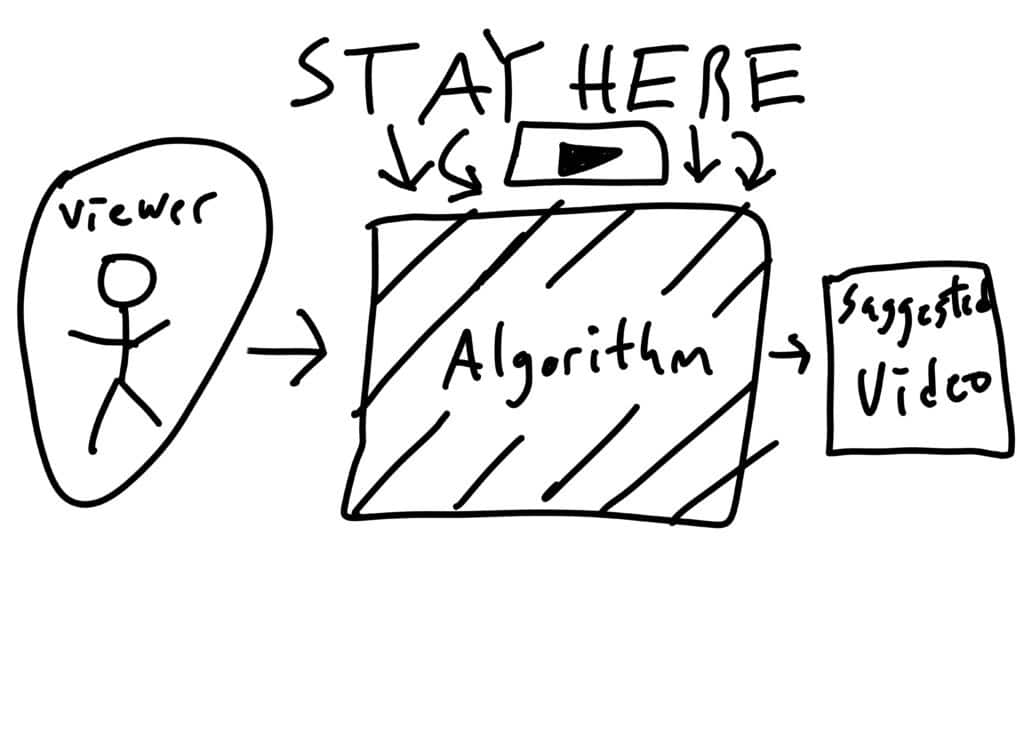
Based on YouTube’s Creator Insider channel and MrBeast’s leaked production document, YouTube’s algorithm has one goal: keep people on YouTube longer.
The algorithm rewards:
✅ High click-through rates (compelling titles/thumbnails)
✅ Strong audience retention (people watch most of your video)
✅ Session duration (viewers watch multiple videos)
✅ Engagement (comments, likes, shares)
✅ Return viewers (people come back)
The algorithm doesn’t care about subscriber count, equipment cost, or hashtag quantity.
🔗 Key Insight: According to MrBeast’s leaked production document, the first minute is crucial – “We lost 21 million viewers in the first minute of the video” is considered normal performance for a successful video.
3.2 HP PRESS Structure
Based on MrBeast’s leaked production document and Alex Hormozi’s content strategy, this framework is proven to work at scale.
A great YouTube video is not an accident. It is engineered. The HP PRESS method is a simple, robust framework for structuring your videos to grab attention, deliver value, and drive action.
H – The Hook (0-8 Seconds)
The average human attention span is now shorter than that of a goldfish. You have, at most, 8-15 seconds to convince a new viewer that your video is worth their time.
The hook is the most critical element of your entire video. A bad hook renders the rest of your video irrelevant, because no one will stick around to see it.
📺 Essential Viewing: The YouTube channel Colin and Samir has an excellent breakdown called “How MrBeast’s Editor Creates Hooks.” It’s a masterclass in the science of attention.
10 Proven Hook Formulas:
- The Bold Promise Hook: “In the next 7 minutes, you are going to learn the exact method I used to double my productivity without working longer hours.”
- The “What If” Hook: “What if everything you’ve been told about building wealth is wrong?”
- The Relatable Problem Hook: “Do you ever sit down to work, open your laptop, and then immediately get distracted by a dozen different things?”
- The Surprising Statistic Hook: “Did you know that 90% of podcasts don’t make it past their third episode? Here’s how to make sure yours isn’t one of them.”
- The “Common Enemy” Hook: “The traditional 9-to-5 is broken. It’s designed to keep you trapped. In this video, we’re going to start planning your escape.”
- The “In Medias Res” Hook: Start your video in the middle of a compelling moment. (e.g., A cooking video that starts with the creator tasting the final dish and having a huge reaction, before saying “Okay, here’s how we made this.”)
- The Question Hook: “What is the single most important investment you can make in your twenties?”
- The “Us vs. Them” Hook: “Most people think you need a lot of money to start investing. They’re wrong. Here’s how you can start with just $100.”
- The Result-Oriented Hook: Show the final result first. (e.g., A woodworking video that shows the beautiful finished table before showing the first piece of wood.)
- The Story Hook: “The worst meeting of my life taught me the most important lesson about public speaking.”
P – Proof & Promise (8-30 Seconds)
After you’ve hooked them, you need to solidify their interest.
Proof: Briefly agitate the pain point you introduced in the hook. Show the viewer you understand their struggle. This builds empathy and trust.
“You’ve probably tried a dozen different to-do list apps, but nothing seems to stick, and you end the day feeling like you were busy but not productive.”
Promise: Clearly state the value proposition of the video. What tangible outcome will the viewer get?
“By the end of this video, you will have a simple, 3-step system that you can implement immediately to get your most important work done.”
R – Roadmap (30-60 Seconds)
Briefly tell the viewer what you’re going to cover. This manages expectations and gives them a reason to keep watching.
“We’re going to cover three main things: first, the psychology of why most to-do lists fail; second, the 1-3-5 rule for daily planning; and third, how to use a simple notebook to stay on track all day.”
E – Execution (Main Content)
This is the main body of your video. Don’t just dump information. Structure it for clarity. A great model for this is the P.I.E. model.
Point: Make your main point. “The most effective way to learn is through active recall.”
Illustration: Provide an example, a story, or a metaphor to make the point concrete. “For example, instead of just re-reading your notes on a historical event, close the book and try to explain the key timeline and figures out loud. The struggle to retrieve the information is what cements it in your memory.”
Explanation: Explain why it works and how to apply it. “This works because it treats your brain like a muscle. Retrieval practice strengthens the neural pathways associated with that information. You can apply this by using flashcards, teaching the concept to a friend, or using a tool like Anki.”
Structure the body of your video as a series of 2-4 P.I.E. segments.
S – Substance (Continued Value)
Continue your writing structure from minute 3 to the end of the video. You still need to provide high value throughout, but at this point the viewer is less likely to click away than they were in the first 3 minutes of the video.
Key Insight from MrBeast’s document: Use “crazy progression” – instead of telling viewers what you will do, show them. If making a survival video, cover multiple days in the first few minutes rather than just the first day.
S – Sell (Call to Action)
Never end your video abruptly and without converting them to do something (subscribe, watch another video, paid ad spot, or all of the above).
Synthesis: Quickly summarize the most important takeaways. “So, to recap: Ditch passive re-reading, embrace active recall by testing yourself, and focus on explaining the concepts in your own words.”
CTA (Call to Action): Tell the viewer exactly what to do next. As a new creator, your primary CTA should be to build your audience.
“If you found this video helpful, you’ll love my Free 99 YouTube Secrets Black Book. It’s packed with more strategies just like this one. Click the first link in the description to download it for free.”
Other CTAs can include subscribing or watching another related video.
3.3 Production Setup
Let’s be crystal clear: Gear does not make the creator. Your message and your connection with the audience are infinitely more important than the camera you use. Start with what you have and upgrade only when you can identify a specific limitation that a new piece of gear will solve.
Level 1: Smartphone Setup (Under $100)
📱 Camera: Your modern smartphone. The cameras on phones made in the last 3-4 years are more than good enough for YouTube.
🎤 Audio: This is more important than video. People will tolerate mediocre video, but they will click away instantly from bad audio.
- $0: Film in a quiet, carpeted room (like a bedroom) to reduce echo. Get close to your phone’s microphone.
- $20-50: A simple lavalier microphone (a “lav mic”) that clips to your shirt and plugs into your phone, like the Boya BY-M1 or the Rode smartLav+.
💡 Lighting:
- $0: Sit facing a large, bright window. Natural light is the most flattering light you can get.
📷 Stability:
- $0: Prop your phone up on a stack of books.
- $25: A simple phone tripod, like the UBeesize 60-inch Tripod Stand.
Level 1: Starter Setup ($50) Record your first video better than 80% of other YouTubers.
| Equipment | Item | Price |
|---|---|---|
| 📱 Camera | Your phone camera | $0 |
| 🎙️ Microphone | Lavalier Professional | $20 |
| 📷 Tripod | UBeesize 51″ | $25 |
| 💡 Lighting | Window light (free!) | $0 |
| 💻 Software | iMovie or DaVinci Resolve | Free |
Level 2: Serious Setup ($1,600) At this level, things look really good, better than 95% of all YouTubers.
| Category | Equipment | Price |
|---|---|---|
| 📹 Camera | Sony a6400 + 50mm lens | $1,000 |
| 🎙️ Audio Setup | ||
| – Microphone | Audio-Technica AT2020 | $100 |
| – Audio Interface | Zoom F3 32-bit | $300 |
| – Headphones | Sony MDR7506 | $100 |
| – XLR Cables | 25ft Cable Matters XLR x2 | $30 |
| 📷 Support | ||
| – Tripod | Neweer Video Tripod | $60 |
| – C-Stand | Neewer Pro | $100 |
| – Sandbag | Amazon Counterweight | $20 |
| 💡 Lighting | Neweer Two-Light Setup | $70 |
| 💾 Storage | ||
| – SD Card | SanDisk 256GB Extreme Pro | $37 |
| – External Drive | WD 5TB My Passport Ultra | $140 |
| – Monitor | Philips 22″ 1080p | $70 |
| 💻 Software | Final Cut Pro or Premiere | $200 |
Level 3: Professional Setup ($16,000) People will ask you if you are a professional videographer; ahead of 99.99% of other YouTubers.
| Equipment | Item | Price |
|---|---|---|
| 📷 Camera | Sony FX3 | $3,200 |
| 🎙️ Audio Setup | ||
| – Microphone | Schoeps CMC641 | $1,600 |
| – Audio Interface | Zoom F3 32-bit | $350 |
| – Headphones | Audio-Technica ATH-M50x | $150 |
| – XLR Cables | Mogami Gold XLR x2 | $100 |
| 🎬 Support | ||
| – Tripod | Sachtler Ace XL | $1,000 |
| – Gimbal | DJI RS 3 Pro | $1,000 |
| 💡 Lighting | Aputure LS C300d II Kit | $2,000+ |
| 💾 Storage | ||
| – SSD | SanDisk 4TB Extreme Pro | $400 |
| – Monitor | BenQ SW271C 4K | $1,300 |
| – Drone | DJI Mavic 3 Pro | $3,900 |
| 🖥️ Software | Final Cut Pro + Adobe Suite | $300 + $55/mo |
Additional Lenses: Sony 24-70mm f/2.8 GM II ($2,300), Sony 16-35mm f/2.8 GM ($2,200)
3.4 The Batch Creation System
The secret that let me quit medicine: I recorded 40 videos before starting residency.
The Weekly Sprint Method Workshop:
| Day | Tasks | Time |
|---|---|---|
| Monday: Research Day | • Generate 10 ideas • Research keywords • Outline 4 scripts • Create title options |
8 hours |
| Tuesday: Script Day | • Write 4 complete scripts • Create thumbnail concepts • Plan B-roll needs • Prepare props/materials |
8 hours |
| Thursday: Film Day | • Set up once (2 hours) • Film 4 videos (4 hours) • Capture B-roll (1 hour) • Reset and organize (1 hour) |
8 hours |
| Weekend: Post-Production | • Edit 1 video to completion • Create thumbnail • Write description • Schedule upload |
4-6 hours |
This system creates one month of content in one week (I now have editors so I don’t edit, but this is what I used to do).
Seasonal Content Calendar Tips:
- January: New Year transformation content (highest conversions)
- March/April: Spring cleaning/fresh start angles
- September: Back-to-school/learning focus
- November/December: Gift guides and year-end reviews
3.5 Content Multiplication

Instead of creating fresh content for every platform, use this multiplication strategy that successful creators like Gary Vaynerchuk document:
Core Content Creation (Once):
- Long-form YouTube video (10-20 minutes)
- Detailed blog post (2,000+ words)
- Comprehensive newsletter (1,000+ words)
Content Multiplication (14+ Pieces):
| Format | Platforms | Time to Create |
|---|---|---|
| Long-Form Adaptations | • Podcast episode • LinkedIn post • Medium article • Email series |
2 hours total |
| Short-Form Content | • Twitter/X thread • Instagram carousel • TikTok clips • YouTube Shorts • LinkedIn video |
3 hours total |
| Visual Content | • Infographic via Canva • Quote graphics • Behind-the-scenes |
2 hours total |
This approach can save 50-70% of creation time while increasing reach by 200-400%, according to Content Marketing Institute research.
3.6 Editing Workflow
Phase 1: Story Edit (Most Important)
- Remove filler words and long pauses
- Cut tangents that don’t serve the message
- Ensure logical flow between points
Phase 2: Polish Edit
- Add B-roll footage
- Include graphics and text overlays
- Background music at -30dB to -40dB
- Color correction for consistency
Software Recommendations:
-
- Beginner: iMovie (Mac) or DaVinci Resolve (free)
- Intermediate: Final Cut Pro or Adobe Premiere Pro
3.7 Analytics & Optimization
Essential Tools:
- YouTube Analytics (free, built-in)
Weekly Optimization Process:
- Analyze recent video performance
- Identify patterns in successful content
- Read audience feedback in comments
- Study competitor strategies
- Apply learnings to upcoming content
- Change low performing titles/thumbnails
🎯 Step 3 Action Items:
☐ Script your next video using HP PRESS
☐ Set up Level 1 equipment (use what you have)
☐ Create content multiplication template
☐ Design 3 thumbnail variations
☐ Batch create your first 3 videos
☐ Join r/NewTubers for feedback
⚡ Quick Win: Your first video will suck. Post it anyway. Perfection is procrastination in a tuxedo. You can always begin again with video #2.
Step 4: Build a Business
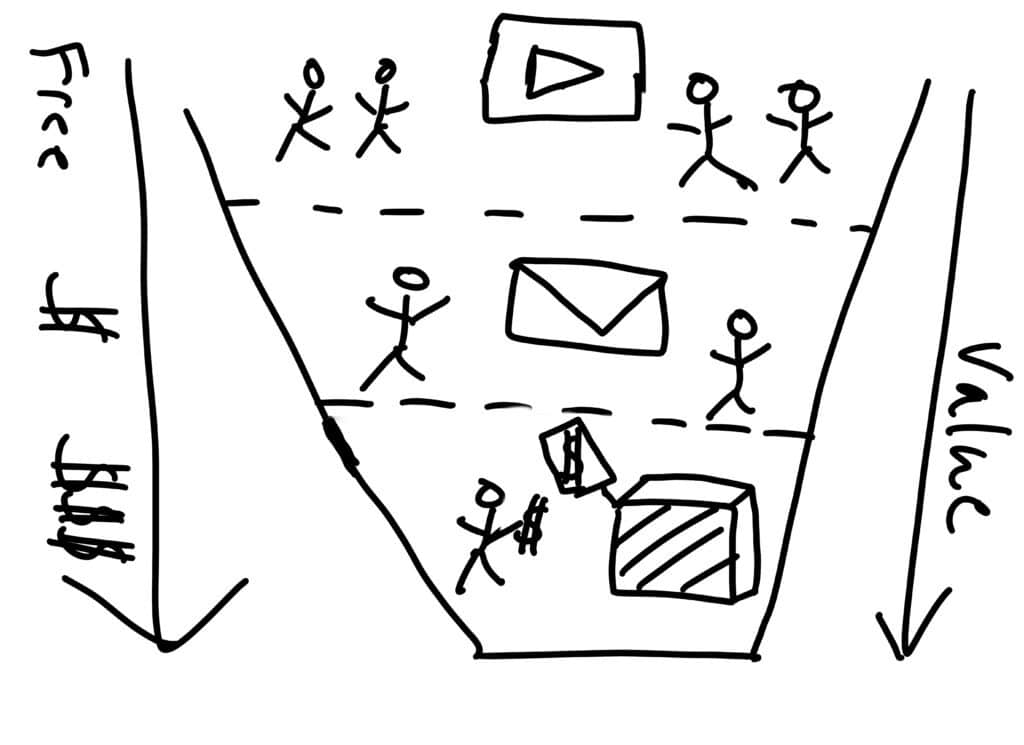
Welcome to the most important part of this entire guide.
It was 3 AM in the hospital. I was mid 18-hour shift and was doom-scrolling through my phone when I saw it: “You made a sale!”
Someone in Australia had bought my Anki course for $197 while I was placing a central line. Then another email. Someone in Germany bought it. Then Canada.
By sunrise, I’d made $1,200. Not from YouTube ads. Not from sponsorships. From my email list.
That’s when I understood: Your email list is your real business. Everything else is just traffic.
If you skip this section, you are not building a business; you are building a hobby that is entirely dependent on the whims of a multi-billion-dollar corporation.
A SoloTuber understands that a YouTube channel is not the business. The channel is the marketing department for the business.
The business itself—your fortress, your truly defensible asset—is built on two pillars: a website you control and an email list you own. This is how you turn fleeting viewers into a loyal community and, eventually, happy customers.
4.1 Website Foundation

While YouTube drives traffic, your website converts visitors to customers. Unlike social platforms, your website is digital property you control completely.
Essential Pages:
- Homepage
- About Me
- Resources
- Articles
- Newsletter
- Products
Homepage Elements:
- Clear headline stating who you help
- Professional photo/video of yourself
- Brief credentials/background
- Preview of best content/products
- Email signup with lead magnet
- Navigation to key sections
Technical Setup:
Domain and Hosting:
- Domain: Cloudflare (.com preferred)
- Hosting: WP Engine (premium/hand-holding) or Cloudways (budget)
- Advanced: Vultr and Gridpane (Thomas Frank’s Guide is amazing)
WordPress Setup: WordPress powers 40% of all websites and offers extensive customization.
4.2 Email Marketing
Email marketing generates $42 for every $1 spent—the highest ROI of any marketing channel.
Platform Selection:
Kit (formerly ConvertKit) (Recommended)
- Built for creators
- Visual automation builder
- Advanced segmentation
- Free for first 1,000 subscribers
Alternatives:
- Mailchimp: Beginner-friendly
- AWeber: Traditional features
- ActiveCampaign: Advanced automation
4.3 Lead Magnets
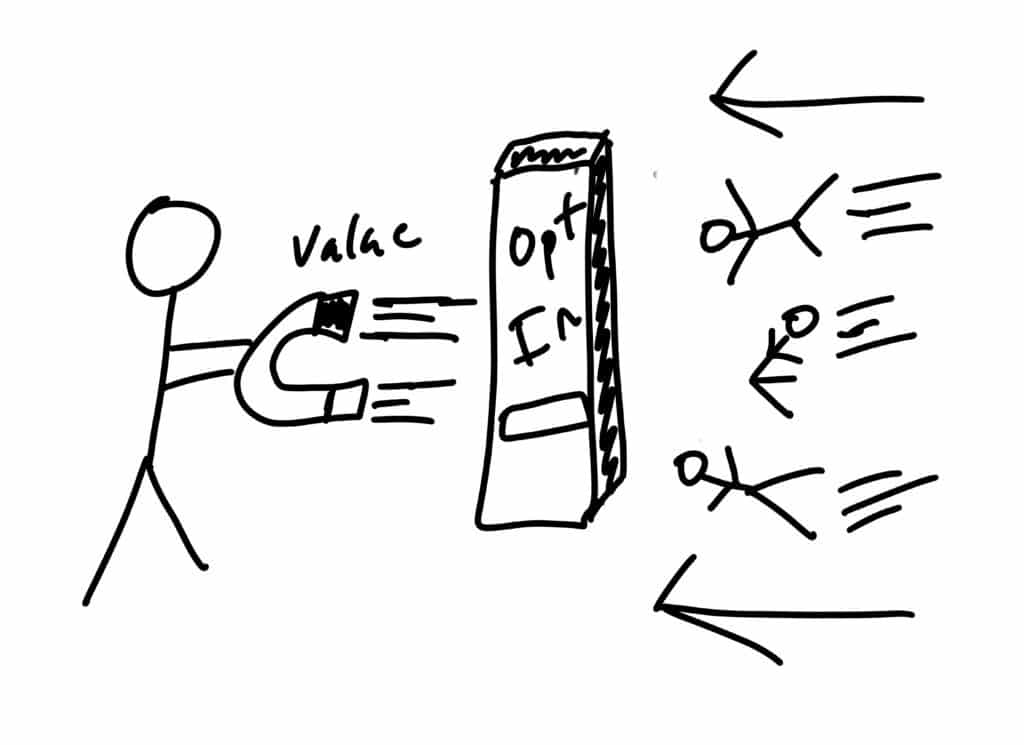
A lead magnet solves a specific problem in exchange for an email address.
I’ve tested 47 different lead magnets. Here’s what actually works:
The Conversion Hierarchy (with real data):
| Type | Example | Conversion Rate | Creation Time |
|---|---|---|---|
| Templates | “YouTube Script Template” | 47% | 2 hours |
| Checklists | “Channel Launch Checklist” | 43% | 1 hour |
| Quick Wins | “First 100 Subscribers Guide” | 41% | 3 hours |
| Mini-Course | “5-Day Productivity Challenge” | 38% | 8 hours |
| Resource List | “Best YouTube Tools 2024” | 31% | 1 hour |
| eBook | “Complete Guide to X” | 22% | 20 hours |
The Winner: Templates. People want to copy-paste their way to success.
The Perfect Lead Magnet Formula:
Name: [Number] + [Desired Result] + [Time Frame] + [Objection Handled]
Examples:
- “5 YouTube Scripts That Got Me 100K Views (Copy-Paste Templates)”
- “The 30-Day Email Challenge That Doubled My Revenue (No Writing Skills Needed)”
- “$10K Month Content Calendar (Works With Just 1,000 Subscribers)”
Creation Process:
- Solve one specific problem
- Make it achievable in <15 minutes
- Design in Canva (use templates)
- Deliver instantly via email
- Follow up with value sequence
PDF Guides and Checklists:
- “10-Point Home Buying Checklist”
- “Ultimate Social Media Content Calendar”
- “5-Day Meal Plan for Busy Professionals”
Templates and Tools:
- Budget spreadsheet templates
- Email outreach templates
- Business plan outlines
Mini-Courses:
- 5-day email productivity course
- 3-part investing video series
- Weekly challenges with daily emails
Creation Tools:
- Canva for design
- Google Docs for writing
- Loom for video content
4.4 Email Sequences
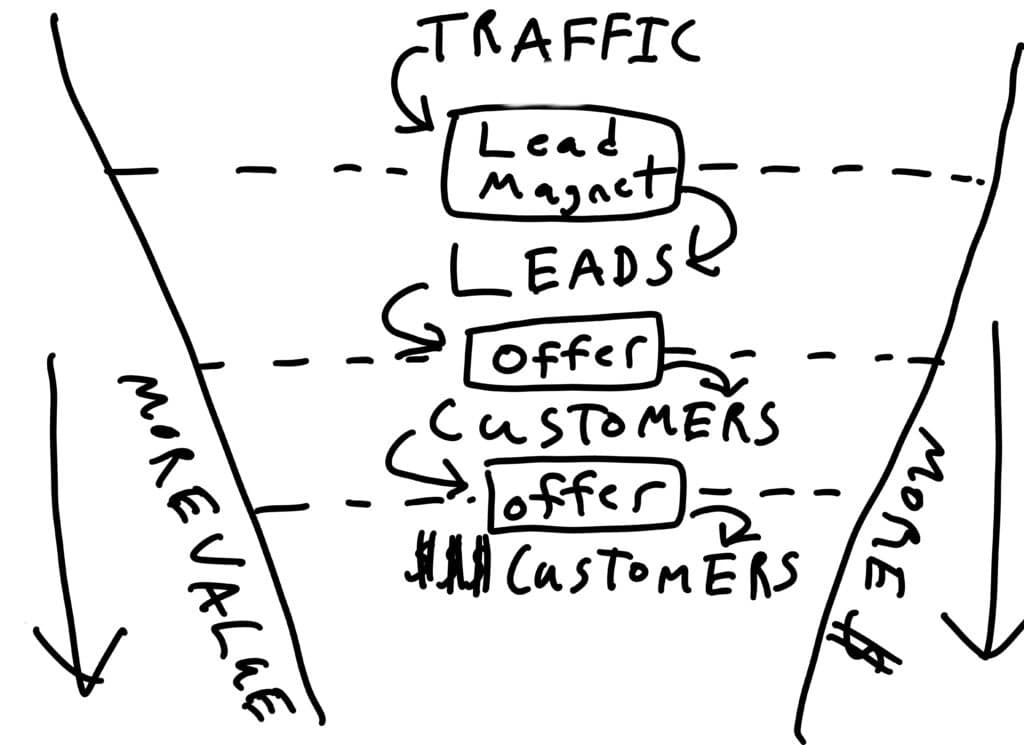
Welcome Sequence (5-7 emails over 2 weeks):
- Email 1: Deliver lead magnet + set expectations
- Email 2: Share your story and background
- Email 3: Provide bonus value related to lead magnet
- Email 4: Customer success story/case study
- Email 5: Address common objections
- Email 6: Soft introduction to paid offerings
- Email 7: Invitation to deeper engagement
Product Launch Sequence (7-10 emails over 2 weeks):
- Emails 1-3: Value-focused content building anticipation
- Email 4: Product announcement with early bird discount
- Email 5: Deep dive into benefits and features
- Email 6: Customer testimonials and results
- Email 7: FAQ addressing objections
- Email 8: Urgency and scarcity elements
- Email 9: Final call with personal story
- Email 10: Cart closing notification
4.5 Business Structure
Business Formation (Consult professionals for your situation)
LLC (Recommended for Most):
- Personal asset protection
- Tax flexibility
- Simple setup and maintenance
- Professional credibility
Financial Management Tools:
- QuickBooks: Comprehensive accounting
- Wave: Free accounting for small business
Payment Processing:
4.6 Product Platforms
For Digital Products:
- Gumroad: Simple setup, handles taxes
- Thinkific: Course platform with payments
- Kajabi: All-in-one (expensive but comprehensive)
For Physical Products:
- Shopify: Complete e-commerce solution
- WooCommerce: WordPress plugin
- Etsy: Marketplace for creative items
4.7 Analytics Tracking
Website Analytics: Google Analytics 4 provides insights on:
- Visitor demographics and behavior
- Traffic sources and popular content
- Conversion rates and goals
- Mobile vs desktop usage
Integration Tools:
- Zapier: Connect apps and automate workflows
- Google Tag Manager: Manage tracking codes
- Hotjar: User behavior analytics
🎯 Step 4 Action Items:
☐ Register domain and set up hosting
☐ Choose email platform and connect
☐ Create your first lead magnet
☐ Write 5-email welcome sequence
☐ Map out your product ladder
☐ Form LLC (or equivalent in your country)
⚡ Quick Win: Your first lead magnet doesn’t need to be perfect. Create a simple checklist based on your most popular video topic. You can improve it later. Remember: version one is better than version none.
Step 5: Products
To transition from “creator” to “business owner,” you must sell something. This can be intimidating, so we’re going to make it a concrete challenge: Launch your first paid product within 90 days of starting your channel.
This creates urgency, forces you to learn by doing, and smashes the mental barrier of asking for the sale.
5.1 Customer Journey
Before purchasing, people go through predictable stages based on consumer psychology research:
Customer Journey Visualization:
| Stage | Awareness | Consideration | Decision | Advocacy |
|---|---|---|---|---|
| Mindset | “I have a problem” | “What are my options?” | “Which is best for me?” | “This changed my life!” |
| Actions | • Discovers you via search • Watches first video • Realizes you can help |
• Binges your content • Joins email list • Compares alternatives |
• Reviews your offerings • Reads testimonials • Makes purchase |
• Gets results • Shares with friends • Buys more products |
| Your Goal | Build trust & authority | Provide massive value | Remove objections | Exceed expectations |
5.2 The MVP Product Launch Formula
Stop perfecting, start profiting. Here’s how to launch your first product in 7 days:
Day 1-2: Validation
- Survey your email list
- Ask: “What’s your biggest challenge with [topic]?”
- Look for patterns in responses
- Pre-sell to gauge interest
Day 3-4: Creation
- Outline based on survey responses
- Record using Loom or smartphone
- Don’t edit—raw is better than perfect
- Focus on transformation, not information
Day 5-6: Sales Page
- Use my PASTOR framework (below)
- Create in Canva or Carrd
- Add payment via Gumroad/Stripe
- Price at 10x the value delivered
Day 7: Launch
- Email your list
- Post in community
- Share on social
- Iterate based on feedback
The PASTOR Sales Page Framework:
- Problem: Agitate their pain point
- Amplify: Show consequences of not solving
- Story: Share your/student transformation
- Testimonials: Prove it works
- Offer: Present your solution
- Response: Clear call to action
5.3 Product Ladder
Don’t try selling expensive products to cold audiences. Build a ladder allowing customers to start small and gradually invest more as trust increases.
Product Ladder Visualization:
| Level | Price Range | Product Types | Purpose | Examples |
|---|---|---|---|---|
| Entry Level | $9-$47 | • eBooks • Templates • Mini-courses • Checklists |
Trust builders | • “YouTube Thumbnail Templates” • “30-Day Content Calendar” |
| Core Level | $97-$497 | • Full courses • Group coaching • Done-for-you services • Workshops |
Problem solvers | • “YouTube Mastery Course” • “6-Week Coaching Program” |
| Premium Level | $997-$4,997 | • 1-on-1 coaching • Masterminds • Done-with-you services • VIP days |
Deep transformation | • “Private YouTube Mentorship” • “Channel Launch Intensive” |
| Continuity Level | $27-$197/mo | • Membership sites • Ongoing coaching • Software tools • Communities |
Ongoing value | • “Creator’s Inner Circle” • “Monthly Q&A Mastermind” |
5.4 Pricing Psychology
Price Anchoring
Present higher-priced options first to make your main offer seem reasonable. Research from MIT Sloan shows this dramatically affects perception.
Value Stacking Example:
- Main course ($497 value)
- Bonus workshop ($197 value)
- Resource library ($147 value)
- Email templates ($97 value)
- Total Value: $938
- Your Investment Today: $297
Payment Plans
Make higher-priced offers accessible:
- 3 payments of $167 instead of $497
- Monthly payments for annual programs
- Seasonal payment options
5.5 Sales Pages
Your sales page is your 24/7 salesperson addressing every question and objection. We talked a little bit about this with “PASTOR” but let’s keep going.
Essential Elements:
Compelling Headline
- Clear benefit or transformation
- Specific, measurable result
- Emotional hook or story
Problem Agitation
- Identify pain point clearly
- Amplify cost of inaction
- Show understanding of struggles
Solution Presentation
- Introduce your method/system
- Explain why it works
- Position as logical solution
Social Proof
- Customer testimonials with results
- Case studies with specifics
- Authority indicators (credentials, media)
Call to Action
- Clear next steps
- Urgency/scarcity elements
- Multiple purchase opportunities
5.6 Advanced Strategies
Webinar Funnels
Live or automated presentations for high-ticket items:
- 45-60 minute valuable content
- Pitch last 10-15 minutes
- Limited-time offers for attendees
- Replay sequences for non-attendees
Use platforms like Zoom or WebinarJam.
Application Funnels
For premium services requiring qualification:
- Application form to qualify prospects
- Discovery call to assess fit
- Customized proposal presentation
- High-touch enrollment process
Affiliate Partnerships
Leverage other creators’ audiences:
- Joint venture partnerships
- Affiliate commission structures (30-50% typical)
- Cross-promotional opportunities
- Bundle collaborations
Tools: ReferralCandy or PartnerStack
5.7 Trust Building
Common Objections and Responses:
| Objection | Response |
|---|---|
| “I don’t have time” | “This system saves time by eliminating trial and error. Most students save 10+ hours per week once implemented.” |
| “It’s too expensive” | “What’s the cost of not solving this problem? Most people spend more on coffee monthly than this course costs.” |
| “Will this work for me?” | “This system worked for [specific examples]. Plus, you’re protected by our 30-day guarantee.” |
5.8 Customer Success
Onboarding Sequences
Help customers get quick wins:
- Welcome package with clear next steps
- Quick-start guides for immediate action
- Success milestones and check-ins
- Community access for support
Ongoing Engagement
Keep customers active and successful:
- Regular check-in emails
- Additional resources and updates
- Community events and challenges
- Advanced training opportunities
Upsell Strategy
Serve existing customers with additional solutions:
- Complementary products
- Advanced training levels
- One-on-one coaching upgrades
- Done-for-you service options
My Actual Daily Routine
Since people always ask, here’s my current daily schedule:
| Time | Activity |
|---|---|
| 4:00 AM | Wake naturally (no alarm) |
| 4:05 AM | Exercise with 10,000 lux light |
| 4:20 AM | Meditate |
| 4:35 AM | Journal & plan day |
| 5:00 AM | First deep work block |
| 8:00 AM | Walk outside (no phone) |
| 9:00 AM | Second deep work block |
| 12:30 PM | Third deep work block |
| 2:30 PM | Done with work (!!) |
| 2:30 PM | First time checking phone |
| 3:00 PM | Gym/sports/sauna |
| 6:00 PM | Family time |
| 8:00 PM | Wind down, sleep |
The secret? No phone for first 10 hours. Try it for one day. Life-changing. This is my weekend plan when I have a regular job and my weekday plan when I don’t.
🎯 Step 5 Action Items:
☐ Survey your audience about their biggest challenge
☐ Create your first MVP product this week
☐ Design your product ladder
☐ Write PASTOR sales page
☐ Set up payment processing
☐ Launch to your email list
⚡ Quick Win: Start with a $27 template pack. It’s easy to create, delivers immediate value, and breaks the mental barrier of asking for money. You can create a premium course later.
Step 6: Scaling and Automation
You’ve built the foundation, created content, grown an audience, and launched products. Now it’s time to transform your YouTube business from a demanding job into a scalable system that runs without you. This final step is where you graduate from being a busy creator to becoming a true business owner—where systems replace hustle, automation replaces repetition, and delegation replaces doing everything yourself.
6.1 The 80/20 Rule
Focus 80% of effort on the 20% of activities generating 80% of results, based on Pareto Principle research.
High-Impact Activities (Focus Here):
- Creating valuable, well-scripted content
- Building and nurturing email list
- Developing and improving core products
- Optimizing high-performing content
- Building strategic partnerships
Lower-Impact Activities (Minimize/Delegate):
- Responding to every comment immediately
- Creating complex graphics/animations
- Obsessing over algorithm updates
- Posting on every social platform
- Perfecting equipment beyond basics
80/20 Analysis Framework:
| Activity | Time Spent | Revenue Impact | Keep/Delegate/Delete |
|---|---|---|---|
| Video editing | 15 hrs/week | Low | Delegate |
| Script writing | 8 hrs/week | High | Keep & Optimize |
| Email marketing | 5 hrs/week | Very High | Keep & Automate |
| Social media posting | 10 hrs/week | Medium | Delegate |
| Product development | 3 hrs/week | Very High | Keep & Expand |
6.2 Standard Operating Procedures

SOPs ensure consistency, enable delegation, and protect business knowledge. Companies with defined processes see 10% higher success rates.
Content Creation SOP Example:
Phase 1: Pre-Production
- Review content calendar for topic
- Research keywords using VidIQ
- Write HP PRESS structure outline
- Create working title and thumbnail concept
- Gather props, B-roll, graphics
- Set up recording environment
Phase 2: Production 7. Record intro hook (3-5 takes) 8. Film main content following script 9. Record call-to-action and end screen 10. Capture additional B-roll if needed 11. Test footage for technical quality
Phase 3: Post-Production 12. Import and organize project files 13. Complete story edit (remove filler, improve flow) 14. Add B-roll, graphics, music 15. Color correct and level audio 16. Create final thumbnail in Canva 17. Write description with timestamps and links 18. Schedule for optimal publishing time
Create SOPs using tools like Notion or Process Street.
6.3 Team Building
Phase 1: Essential Contractors (Months 6-12)
| Role | Responsibilities | Cost | Where to Hire |
|---|---|---|---|
| 🎬 Video Editor | • Post-production • B-roll insertion • Graphics/text • Color/audio |
$50-200/video | • Upwork • Fiverr • Facebook groups |
| 🎯 Virtual Assistant | • Email management • Social posting • Research • Calendar |
$5-15/hour | • Upwork • Philippines VA sites • OnlineJobs.ph |
| 🎨 Graphic Designer | • Thumbnails • Social graphics • Lead magnets • Website design |
$25-75/graphic | • 99designs • Fiverr • Dribbble |
Phase 2: Strategic Team Members (Year 2+)
✍️ Content Writer/Researcher
- Research trending topics
- Write blog posts and email content
- Create social media captions
- Develop course outlines
👥 Community Manager
- Respond to comments and messages
- Moderate online communities
- Create engagement posts
- Identify customer feedback
📊 Business Manager
- Manage team and contractors
- Oversee project timelines
- Handle business development
- Manage partnerships
6.4 Automation Systems
Email Marketing Automation
Set up sequences running automatically using platforms like Kit or ActiveCampaign:
Lead Nurture Sequences:
- Welcome series for new subscribers
- Weekly value-focused newsletters
- Seasonal promotion campaigns
- Win-back campaigns for inactive subscribers
Customer Journey Automation:
- Post-purchase onboarding
- Product usage tips and support
- Upsell sequences for related products
- Review and testimonial requests
Social Media Automation
Use tools like Buffer, Typefully, or Hootsuite:
- Schedule posts across platforms
- Auto-share new YouTube videos
- Repost high-performing content
- Cross-post with platform-specific formatting
Customer Support Automation
- FAQ chatbot via Intercom
- Automated email responses
- Help desk software like Freshdesk
- Knowledge base with Helpjuice
- There are many AI tools that do this now as well.
6.5 Revenue Diversification
Multiple Income Streams Strategy:
| Revenue Type | % of Total | Examples | Stability |
|---|---|---|---|
| Primary Revenue | 60-70% | • Digital courses / Products • Coaching programs • High-ticket services |
High |
| Secondary Revenue | 20-30% | • Affiliates • Sponsorships • Merchandise • Speaking fees |
Medium |
| Passive Revenue | 10-20% | • Investment income • Licensing deals • Book royalties • Real estate |
Very High |
6.6 Advanced Marketing
Joint Venture Partnerships
Collaborate with complementary creators:
- Cross-promote products
- Create bundle offers
- Co-host webinars or events
- Guest on each other’s content
Affiliate Program Development
Let others promote your products:
- Recruit successful students as affiliates
- Partner with influencers in related niches
- Provide marketing materials and training
- Offer competitive commissions (30-50%)
Use tools like ReferralCandy or PartnerStack, but be careful here, whatever you advertise/refer is a representation of yourself.
Content Syndication
Expand reach through partnerships:
- Guest posting on industry blogs
- Podcast guest appearances
- Industry publication contributions
- Speaking at virtual/in-person events
6.7 Financial Management
Profit-First Approach (Based on Mike Michalowicz’s research):
| Account | Percentage | Purpose |
|---|---|---|
| Operating Expenses | 50% | Business costs |
| Owner’s Pay | 20% | Your salary |
| Profit | 15% | Business savings |
| Tax Account | 10% | Quarterly payments |
| Emergency Fund | 5% | Unexpected costs |
Investment Strategy
Use business profits wisely:
- Reinvest in better tools and team
- Diversify into stocks/bonds/real estate
- Fund product development and innovation
- Build 6-12 months emergency fund
Tax Optimization
Work with qualified professionals:
- Maximize business expense deductions
- Structure business for tax efficiency
- Plan quarterly estimated payments
- Understand international implications
6.8 Success Metrics
Dashboard Metrics to Track:
| Category | Metrics | Target | Tool |
|---|---|---|---|
| Content | • Average retention • CTR on thumbnails • Subscriber growth • Engagement rate |
• >50% • >10% • +10%/month • >5% |
YouTube Analytics |
| Business | • Email list growth • Open/click rates • Conversion rate • Customer LTV • Monthly revenue |
• +20%/month • 25%/5% • >2% • >$500 • Freedom Number |
Kit, Google Analytics |
| Efficiency | • $/hour worked • Cost per acquisition • Team productivity • Content ROI |
• >$200 • <$50 • 80%+ • >300% |
Custom tracking |
Use dashboards in Google Analytics, Mixpanel, or Klaviyo for tracking.
6.9 Long-Term Scaling
Horizontal Scaling (Expand Offerings)
- Launch products in adjacent niches
- Create different difficulty levels
- Develop industry-specific variations
- Add service-based offerings
Vertical Scaling (Deepen Relationships)
- Create multi-level certification programs
- Build exclusive mastermind communities
- Offer done-for-you implementation
- Develop licensing opportunities
Geographic Scaling (Expand Markets)
- Translate content into other languages
- Partner with local influencers
- Adapt products for different cultures
- Establish international business entities
6.10 Building a Sellable Asset
Even if you never plan to sell, build like you will. Here’s why:
Benefits of Building to Sell:
- Forces systematic thinking
- Creates measurable value
- Reduces owner dependence
- Maximizes profitability
- Provides exit options
The Asset Value Formula:
Business Value = (Annual Profit × Industry Multiple) + Strategic Value
Industry Multiples (2024, this varies dramatically by sector):
| Asset Type | Multiple | Example Value |
|---|---|---|
| Email lists | 3-5x annual profit | $100K profit = $300-500K value |
| Course businesses | 2.5-4x annual profit | $100K profit = $250-400K value |
| SaaS/Membership | 3-6x annual profit | $100K profit = $300-600K value |
| YouTube channels | 1-3x annual profit | $100K profit = $100-300K value |
Building Sellable Assets:
- Document all systems and processes
- Build team that operates without you
- Establish predictable revenue streams
- Create intellectual property portfolio
Potential Exit Options:
- Sell to larger company in your industry
- License content and systems
- Merge with complementary business
- Pass to family member or key employee
- Maintain as passive income source
Your 52-Week Implementation Roadmap
| Phase | Weeks | Key Milestones |
|---|---|---|
| Foundation | 1-10 | • Choose niche & calculate Freedom Number • Create first video with HP PRESS • Set up website + email capture • Launch first lead magnet • Develop first paid product ($9-47) |
| Growth | 12-20 | • Create cross-sell offers • Redesign channel branding • Create video description SOPs • Implement 80/20 analysis |
| Systems | 22-30 | • Create all core SOPs • Form LLC/business structure • Build customer service systems • Take first vacation week |
| Delegation | 32-40 | • Identify delegation opportunities • Create swipe files • Hire first team member • Implement team systems |
| Scale | 42-52 | • Generate next 100 video ideas • Plan core product ($97-497) • Create and launch core product • Celebrate and plan year two! |
Conclusion
You now have the complete, evidence-based blueprint for building a profitable YouTube business. These six steps—Foundation and Mindset, Finding Your Niche, Creating Quality Content, Building Infrastructure, Converting Viewers to Customers, and Scaling with Systems—form a comprehensive roadmap from zero to financial freedom.
Your first video won’t be perfect. Your first product might have flaws. Your first sales funnel may convert poorly. That’s not failure—that’s learning. Every successful creator went through the same messy, uncertain beginning.
The most important step is the first one. Start where you are, with what you have, right now.
You are just one video away from changing your trajectory. The only question is: will you take action, or will you remain in the same place you are today?
Your freedom is waiting. The data supports it. The systems are proven. The tools are available.
Remember, why are you doing this?
To build a life of freedom and happiness! If this is killing you or feels like a real struggle, you don’t have to do it. Seriously. Consider your life. What’s important to you? What makes you happy and healthy? Are you doing this because you “should” do it or because you want to do it?
Your SoloTuber Commitment
I want you to make a commitment. Not to me, but to yourself.
Print this out. Sign it. Put it where you’ll see it daily.
THE SOLOTUBER COMMITMENT
I, _________________________, commit to:
☐ Uploading my first video within 7 days ☐ Building my email list starting today ☐ Creating value, not chasing views ☐ Focusing on systems, not perfection ☐ Giving myself permission to suck at first ☐ Not quitting for at least 100 videos ☐ Beginning again whenever I fall
My Freedom Number is: $______________
My target “quit my job” date is: ______________
Signed: _______________________________
Date: _________________________________
The Future Is Yours
Right now, someone with half your knowledge is making $10,000/month teaching what you know for free.
Right now, someone with worse equipment is building an audience in your niche.
Right now, someone less qualified is living your dream life.
The only difference? They started.
Your YouTube channel isn’t just videos and views. It’s your path to:
- Financial freedom
- Location independence
- Time sovereignty
- Meaningful impact
- Personal fulfillment
The RegTubers will keep chasing algorithms. They’ll burn out in 18 months.
But you? You’re a SoloTuber now. You build systems. You create value. You own your future.
And most importantly? You know you can always begin again.
One Final Note
If you upload your first video using this system, I want to know about it. Seriously.
Email me: [email protected]
Tell me:
- Your niche
- Your first video topic
- Your biggest fear
- Your Freedom Number
I read every email. And who knows? Your story might be the one that inspires another doctor, lawyer, or corporate prisoner to finally take the leap.
Remember: You’re not just building a YouTube channel. You’re building a life you don’t need a vacation from.
Now stop reading. Start creating. Begin again.
Your future audience is waiting.
Acknowledgments
This guide exists because giants let me stand on their shoulders:
- Ali Abdaal, for showing me doctors can be creators
- My friend Nino, for teaching me to begin again
- My parents, for sacrificing everything
- Every patient who taught me what matters
- And you, for believing you have something worth sharing
Start building your YouTube business today.
“The best time to plant a tree was 20 years ago. The second best time is now.” — Chinese Proverb
Now go plant your tree. 🌳
And remember: You can always begin again.
P.S. – Yes, this guide is 20,000+ words. Yes, it could have been shorter. But you’re not looking for quick tips. You’re looking for transformation. And transformation requires depth. Now you have everything you need. Use it.
P.P.S. – Seriously, email me when you start. I mean it. We’re in this together.
Popular Articles
Recent Articles
Free Resources
99 YT Secrets Black Book
Find Your Creator Personality Type
Premium Resources
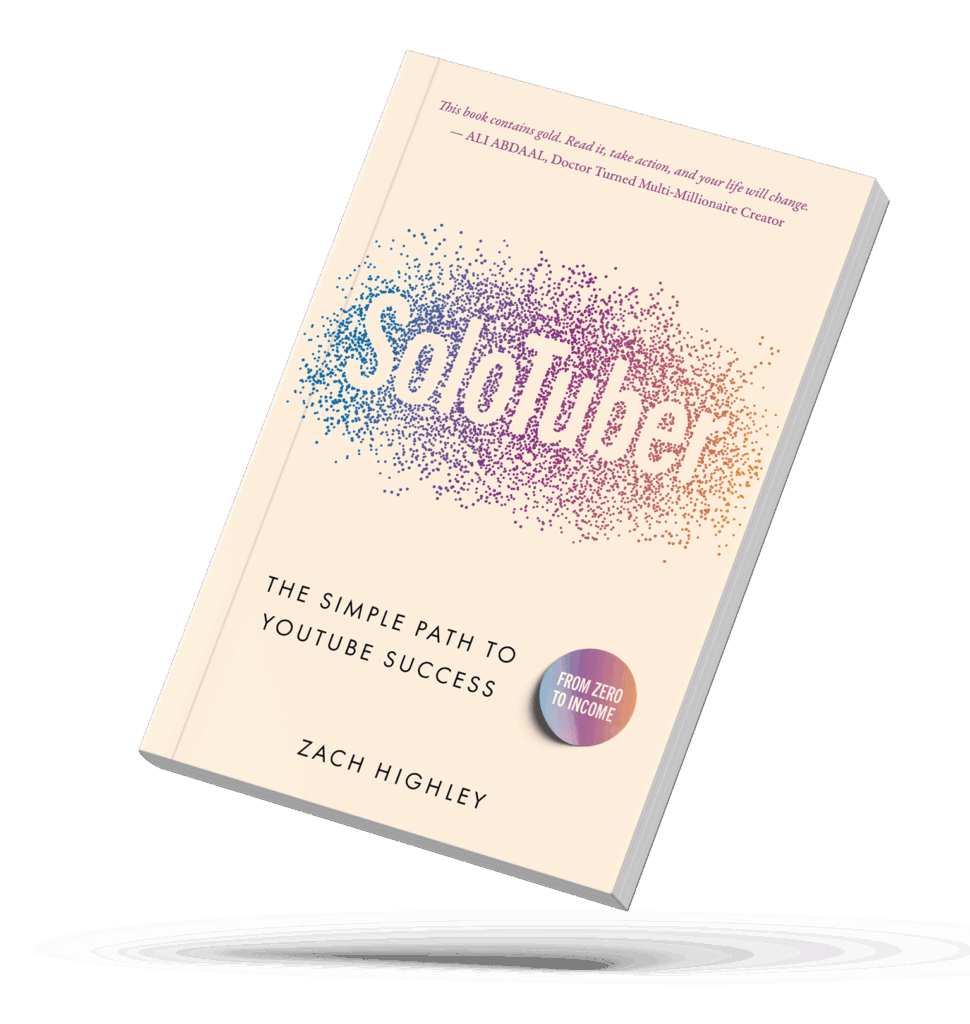
SoloTuber - $2.99
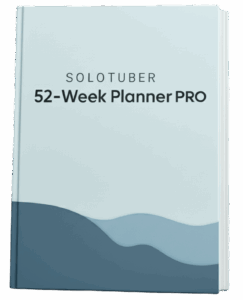
52-Week Content Planner - $7

Creator Toolkit Bundle - $77
SOLOTUBER PRO
Get Gauranteed YouTube Success
Get More Like This Every Tuesday (Join 5,000+ Readers)
Change Your Life (Based on Evidence)
Toolkit: 11 tools that changed my life
11 tools that changed my life

